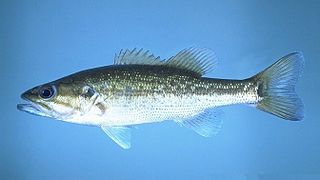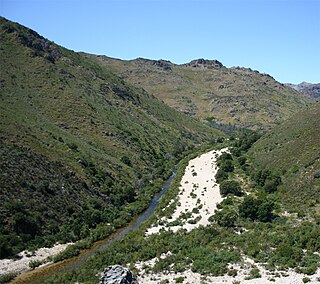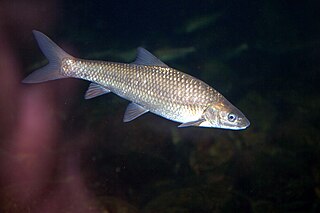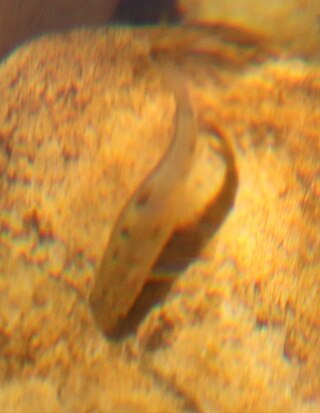
The spotted bass, also called spotty, or spots in various fishing communities, is a species of North American freshwater fish belonging to the sunfish family (Centrarchidae) of the order Perciformes. It is noted for the rows of dark spots below the lateral line, which give it its common name. One of the black basses, it is native to the Mississippi River basin and across the Gulf states, from central Texas through the Florida panhandle. Its native range extends into the western Mid-Atlantic states and it has been introduced into western North Carolina and Virginia. It has also been introduced to southern Africa, where it has become established in some isolated waters as an invasive species.

The smallmouth bass is a species of freshwater fish in the sunfish family (Centrarchidae) of the order Perciformes. It is the type species of its genus Micropterus, and is a popular game fish sought by anglers throughout the temperate zones of North America, and has been spread by stocking—as well as illegal introductions—to many cool-water tributaries and lakes in Canada and more so introduced in the United States. The maximum recorded size is approximately 27 inches (69 cm) and 12 pounds (5.4 kg).

The largemouth bass is a carnivorous freshwater ray-finned fish in the Centrarchidae (sunfish) family, native to the eastern and central United States, southeastern Canada and northern Mexico. It is known by a variety of regional names, such as the widemouth bass, bigmouth bass, black bass, bucketmouth, largie, Potter's fish, Florida bass, Florida largemouth, green bass, bucketmouth bass, green trout, Gilsdorf bass, Oswego bass, LMB, and southern largemouth and northern largemouth.

The redeye bass, redeye, or Coosa bass is a species of freshwater fish in the sunfish family (Centrarchidae) native to the Coosa River system of Georgia, Alabama. The waters it is normally found in are cool streams and rivers in the foothills of mountains.

The Suwannee bass is a species of freshwater fish in the sunfish family (Centrarchidae) of order Perciformes. One of the black basses, This species is native to just two river systems in Florida and Georgia, although it has been introduced elsewhere.

The shoal bass is a species of freshwater fish in the sunfish family (Centrarchidae) of order Perciformes. One of the black basses, it is native to waters in Florida and Georgia. It is also occasionally found in rivers and streams of East Alabama where it has been declared an endangered species and cannot legally be kept if caught by fishermen. Of typical size for a black bass, M. cataractae reaches a maximum recorded length of 24 inches (61 cm) and a maximum published weight of 8 pounds, 12 ounces.

The Guadalupe bass is a rare species of fish endemic to the U.S. state of Texas, where it also is the official state fish. It is restricted to creeks and rivers, and is listed as near threatened. Today, most fly fishermen and anglers practice catch-and-release techniques to improve fish populations. The Guadalupe bass is often difficult to distinguish from the smallmouth bass or spotted bass, and the fish is known to hybridize.

The Olifants River is a river in the northwestern area of the Western Cape Province of South Africa. The upper and main catchment area of the Olifants river is around Ceres and the Cederberg mountains. The Clanwilliam and Bulshoek dams are located on the river and provide water for the towns and farms along the watercourse. The river is approximately 285 km long with a catchment area of 46,220 km2. It flows into the Atlantic Ocean at Papendorp, 250 km north of Cape Town.

The Berg River is a river located just north of Cape Town in the Western Cape Province of South Africa. It is approximately 294 km (183 mi) long with a catchment area of 7,715 km2 (2979 mi2) and debouches into the Atlantic Ocean. About 65% of the Berg River area is under agriculture. The major towns in the Berg River area are Velddrif and Laaiplek near the coast, Piketberg, Hopefield, Moorreesburg and Darling further inland.

Pseudobarbus is a ray-finned fish genus in the family Cyprinidae. The type species is Burchell's redfin. The scientific name is derived from the Ancient Greek pseudes ("false") and the Latin word barbus. This genus contains some of the South African redfins. It was originally proposed as a subgenus, but has since been found worthy of recognition as a full genus.

The Cape whitefish or Berg-breede River whitefish is a ray-finned fish species in the family Cyprinidae. It was formerly placed with the South African redfins in Pseudobarbus. It is tetraploid. Its closest living relative is the sawfin.
The Clanwilliam redfin, is a ray-finned fish species in the family Cyprinidae. It was formerly placed with the South African redfins in Pseudobarbus. It is tetraploid. Its closest living relative is the Twee River redfin.

The Clanwilliam yellowfish is a ray-finned fish species in the family Cyprinidae. It has long been placed in Barbus, the "wastebin genus" for barbs, by default; however, the species is increasingly being restored to related yellowfish genus Labeobarbus which seems a much more appropriate placement. It is hexaploid like the other yellowfish, among which it is more closely related to the smallscale yellowfish than to the largescale yellowfish.
The Twee River redfin or simply Twee redfin is a ray-finned fish species in the family Cyprinidae. It was formerly placed with the South African redfins in Pseudobarbus. It is tetraploid. Its closest living relative is the Clanwilliam redfin.
The sawfin, also known as Clanwilliam sawfin, is a ray-finned fish species in the family Cyprinidae. It was formerly placed with the South African redfins in Pseudobarbus. It is tetraploid. Its closest living relative is the Cape whitefish . This sizeable cyprinid can grow to over 40 centimetres (16 in) long and weigh more than 3 kg.

The Eastern Cape redfin is an African freshwater fish species in the family Cyprinidae, this appears to be a species complex rather than a single species.

The smallscale redfin is a freshwater fish in the family Cyprinidae which is endemic to South Africa. It is threatened by habitat destruction and the impact of invasive species.

Burchell's redfin, also known as the Tradouw redfin, Tradou redfin or Breede redfin, is an African freshwater fish species in the family Cyprinidae. P. burchelli is the type species of its genus Pseudobarbus, and like all of these is tetraploid. The Berg River redfin is a very close relative.

The Berg River redfin or Berg redfin is an African freshwater fish species in the family Cyprinidae. The Burchell's redfin, the type species of its genus Pseudobarbus, is a very close relative. The Berg River redfin is tetraploid.
















